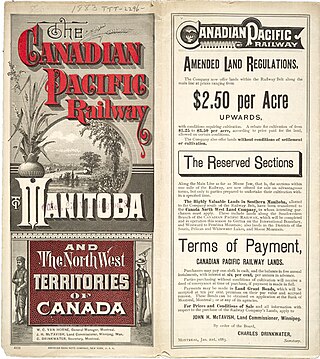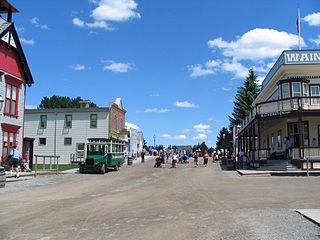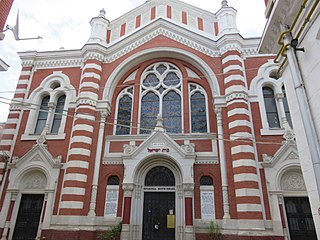Beth Israel may refer to:

Carpenter Gothic, also sometimes called Carpenter's Gothic or Rural Gothic, is a North American architectural style-designation for an application of Gothic Revival architectural detailing and picturesque massing applied to wooden structures built by house-carpenters. The abundance of North American timber and the carpenter-built vernacular architectures based upon it made a picturesque improvisation upon Gothic a natural evolution. Carpenter Gothic improvises upon features that were carved in stone in authentic Gothic architecture, whether original or in more scholarly revival styles; however, in the absence of the restraining influence of genuine Gothic structures, the style was freed to improvise and emphasize charm and quaintness rather than fidelity to received models. The genre received its impetus from the publication by Alexander Jackson Davis of Rural Residences and from detailed plans and elevations in publications by Andrew Jackson Downing.

A block settlement is a particular type of land distribution which allows settlers with the same ethnicity to form small colonies. This settlement type was used throughout western Canada between the late 19th and early 20th centuries. Some were planned and others were spontaneously created by the settlers themselves. As a legacy of the block settlements, the three Prairie Provinces have several regions where ancestries other than British are the largest, unlike the norm in surrounding regions.

Beth Hamedrash Hagodol is an Orthodox Jewish congregation that for over 120 years was located in a historic building at 60–64 Norfolk Street between Grand and Broome Streets in the Lower East Side neighborhood of Manhattan, New York City. It was the first Eastern European congregation founded in New York City and the oldest Russian Jewish Orthodox congregation in the United States.

The Big Muddy Badlands are a series of badlands in southern Saskatchewan, Canada, and northern Montana, United States, in the Big Muddy Valley and along Big Muddy Creek. Big Muddy Valley is a cleft of erosion and sandstone that is 55 kilometres (34 mi) long, 3.2 kilometres (2.0 mi) wide, and 160 metres (520 ft) deep.

Congregation Beth Israel is a Reform Jewish congregation and synagogue, located at 1931 NW Flanders Street, Portland, Oregon, in the United States.

Beth Israel Synagogue is a Modern Orthodox synagogue located at 131 Wolf Willow Road NW in the Oleskiw neighbourhood of Edmonton, Alberta, Canada. Founded in 1906 as the Edmonton Hebrew Association, it is the city's oldest synagogue.
The history of the Jews in Vancouver in British Columbia, Canada has been noted since the mid-19th century.

Congregation Beth Israel is a Reform Jewish congregation and synagogue located at 5600 North Braeswood Boulevard, in Houston, Texas, in the United States. The congregation, founded in 1854, is the oldest Jewish congregation in Texas; and it operates the Shlenker School.

The Little Synagogue on the Prairie is a small, wooden synagogue originally built in Sibbald, Alberta, just west of the Alberta-Saskatchewan border. Originally called the Montefiore Institute, it was built in 1913 or 1916 by the Montefiore colony of Jewish immigrants who had settled in Alberta in 1910, named after Sir Moses Montefiore. It is one of the few surviving examples of the small, wooden synagogues that were built by pioneers on the Canadian and American prairie.
Synagogues may be considered "oldest" based on different criteria, and can be oldest in the sense of oldest surviving building, or oldest in the sense of oldest congregation. Some old synagogue buildings have been in continuous use as synagogues, while others have been converted to other purposes, and others, such as the Touro Synagogue, were shuttered for many decades. Some early established congregations have been in continuous existence, while other early congregations have ceased to exist.
Edenbridge was a Jewish farming settlement northeast of Melfort, Saskatchewan. Its first residents came from Lithuania via South Africa. The name is an Anglicization of Yid'n Bridge, for a nearby bridge over the Carrot River.

Congregation Beth Israel is a Reform Jewish congregation and synagogue, located in Meridian, Mississippi, in the United States. Founded in 1868 and a member of the Union for Reform Judaism, the congregation's first permanent house of worship was a Middle Eastern-style building constructed in 1879. The congregation moved to another building built in the Greek Revival style in 1906, and in 1964 moved to a more modern building, out of which they still operate.

The Rural Municipality of Willow Creek No. 458 is a rural municipality (RM) in the Canadian province of Saskatchewan within Census Division No. 14 and SARM Division No. 4.

Mount Sinai Temple is an historic former Reform synagogue located in Sioux City, Iowa, in the United States. The building was listed on the National Register of Historic Places in 1999.

The Brașov Synagogue, officially the Beth Israel Synagogue in Brașov is a Neolog Jewish congregation and synagogue, located at 29 Poarta Șchei Street in the center of Brașov, in Transylvania, Romania. Designed by Lipót Baumhorn in the Hungarian Secession style, the synagogue was completed in 1901, and is situated behind the street front, on a plot surrounded by houses. The synagogue plays a ritual role and the building complex includes a community seat and a kosher restaurant.
The city of Cumberland, Maryland is home to a small and declining but historically significant Jewish community. The city is home to a single synagogue, B'er Chayim Temple, one of the oldest synagogues in the United States. Cumberland has had a Jewish presence since the early 1800s. The community was largest prior to the 1960s, but has declined in number over the decades. Historically, the Jewish community in Cumberland maintained several synagogues, a Jewish cemetery, and a Hebrew school. By 2019, Cumberland's Jewish community had its lowest population point since the early 1900s.












